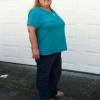Search the Community
Showing results for 'revision'.
Found 17,501 results
-


What should a newbie expect?
jeanieG replied to MamaC's topic in Mexico & Self-Pay Weight Loss Surgery
I can give you a referral. Dr. Ramos Kelly in Tijuana did mine (revision from lapband to VSG) and my niece's vsg and was great, the whole experience was great. They treat you wonderful and you can talk directly to the doctor if you want, that isn't a big deal at all. I did a lot of research before going down there and there were about 3 I had decided on and narrowed it down to him. I have heard about many good ones in Mexico. After doing research get on all the forums you want and search out that doctor's name and communicate with people who have actually had it done by the doctor you are considering...that is the best referral system, a testimony! There might be people not satisfied with him, I don't know. Everyone has there on priorities and needs look into who fits their wants and needs. I appreciated all the names and numbers I could get when I was doing research. Try and book directly through the doctor not an agency if possible. Here is their email for information: wls-clinic@hotmail.com or website http://www.ramoskellymd.com/ the coordinator there is name Omar and he is exceptionally nice and helpful. I am not saying just go to him but I'm just giving you a start on your research. everyone needs to pick their own doctor of course. Here is my video of our time there. Good luck with your research and decision. feel free to ask me any questions. -
I have a job with heavy lifting and right now at 16 days, I still cannot lift a gallon of milk without it being shaky tiring. Knocks me down for quite awhile. Saw my MD for the 2 week check up 4/25 and the normal he approves for disability time out is 3 weeks and told me 4 weeks would be better for me since mine was a revision lapband removal and VSG in the same procedure. Today is my first day I have been able to back off on the pain meds. And I still have leaky incisions...that would not be good at work
-


First Week at Home Question
Cindy Currie Anderson replied to phazer08's topic in Gastric Bypass Surgery Forums
I had revision surgery on Wednesday and cooked for my family on Sunday. I didn't need any help at all. Actually would have preferred to be alone. Lol -
I got my band in July 2013. I lost 25 lbs during the pre-surgery liquid diet, but only 10 additional lbs in the following year. I had issues with the band once I started getting fills. I had a hard time keeping food down and threw up almost every time I ate solid food. My surgeon then started the fill/unfill game. I went back and forth so many times. While this was going on, I continued to have unrelenting port pain. It was unbearable from the day I had surgery. My surgeon said that I'd get used to it, but I never did. It just hurt all the time. It prevented me from exercising, sleeping, and I couldn't even sit in a chair in the same position for too long. In May 2014, my surgeon basically washed his hands of me. He unfilled my band completely and told me that it had to be removed because my body just "rejected" it. He also told me that he would not recommend another surgery for me. I regained 30 of the 35 lbs I lost. I got a second opinion and had a revision to gastric bypass 3 weeks ago. My new surgeon told me that he had never seen a lapband port placed in the position mine was in. He said that it was too high and was sitting right on top of my highest rib. He wasn't surprised at all that I had so much pain. Vindication! My surgeon and PCP both doubted my pain when I complained about it ALL THE TIME. Long story short - I'm thrilled to have the band and port out of me! I'm still on the mushy food phase right now with bypass, but so far so good. I don't have any hunger at all and have to remind myself to eat. That's something that never happened with the band. I'm much happier and more comfortable. The port pain really put a damper on my life for 1.5 years. So glad it's GONE!! Since the day of the revision surgery, I have lost 21 lbs.
-
I'm scheduled for revision on August 29 - a Monday...taking the week off and then will have Labor Day off as well. My husband will be there for surgery and 2 days in hospital and bring me home...but then has an event out of town on Thursday that he wants to go to over the weekend. I was single when I had the lapband done and managed just fine. I have friends I can call. I am fine with him leaving, but just wanted to get some reassurance for both him and me. He feels bad (sort of) and I want him to go. Just need some idea of the condition I'll be in that first week. Thanks
-


Should LapBandTalk have forums for OTHER Weight Loss Surgeries?
JaimeSTL replied to Froggi's topic in General Weight Loss Surgery Discussions
I completely agree with what Georgia girl said. When I joined LBT, I'd already been to OH and didn't like the vibe, the bashing, etc. I definitely don't want to see that kind of thing here. Froggi isn't the only person who has questioned the addition of the forums for other surgeries. I can see a need for a revision forum, but not forums for each WLS on what is supposed to be a lap band specific board. -
Hi everyone! I am having my revision from band to VSG on 6/17 and I am stressing about the downtime from the gym afterward. My doctor told me that I could walk immediately, but hold off on aerobics until 3 weeks and weights 4 weeks. Abs will have to wait for 6-8 weeks depending on how I heal. My normal routine is 4-5 days at the gym for 1 to 2 hours each time. I generally do classes such as spin, cardio blast, step & sculpting. I am excited that I found this group!
-
Quick recap- I had the sleeve on 2/5/2014 and had tons of complications. I was in the hospital a lot, I had a PICC line and then a feeding tube. It was a rough 6 months. My stomach basically didn’t tolerate food or drink, so there was a lot of puking. Fast forward to needing a revision to bypass on 6/26/2018 due to severe reflux and damage. The surgery went great, I healed well, no nausea. I was rocking it. I am doing great on full liquids but am failing miserably on soft foods. I don’t know if it’s psychological or what. I can do one cheese stick a day if I chew very well. I am okay with yogurt, just small amounts. I get sick on refried beans, cottage cheese, eggs, etc. I just keep going back to full liquids. Anyone else? Any advice?
-
All I can say is that it gets better. I had revision surgery from lap-band to RNY on April 29th. First 3-4 weeks was not great at all. Everything I ate made me feel sick. But you can get thru it. I decided pre-surgery that I wouldn't weigh myself more than once a week. And I've pretty much stuck to that and it really helps because you are better able to see the results.
-


Switched Procedure From Band To RNY Today
ElleG replied to Kathy Pitcher's topic in PRE-Operation Weight Loss Surgery Q&A
I currently have a band and I'm trying to get a revision to the bypass. The band was not the right choice for me. I would listen to the doc. It sucks to go thru the pain of the surgery for nothing, now I have to do it again. I have faith the bypass will be the right thing for me. Best Wishes -
I did the RNY on Jun but I can eat almost everything even the potato chips. can you eat those things? and what happen to you if you do eat them? how much of food you can tolerate to eat in the same time? actually, I had a gastric banding revision to RNY and it's really new situation for me.
-


TOGA to sleeve revision anyone?
jaysonhouston replied to Momluvspink's topic in Revision Weight Loss Surgery Forums (NEW!)
I too had my procedure with UT Houston/Dr. Wilson and lost 60 pounds but put about 20 back on. I was wandering how your revision surgery to the Gastrics Sleeve went ? J -
I m not feeling my restriction either. I got to 163 then now up to 180 in short time. Thinking about revision. Tried cutting cal etc. had lot of stress Sick parent etc.
-


Banded for 3 years and struggling with reflux
marfar7 replied to CAROLYNFC's topic in LAP-BAND Surgery Forums
Have u had a recent xray? 3 yrs of a lapband, almost daily vomiting, I suffered severe nighttime reflux. My band had slipped. gained 30 lbs back during the year I was unfilled. Last July I had a sleeve revision. Sometimes reflux is the ONLY symptom of a slip. I had a minor slip that turned into a major slip and couldn't be fixed on it's own. Good luck! I know how miserable reflux is. -


Can't drink Protein, HELP!
rosstheboss replied to Tessa1988's topic in Protein, Vitamins, and Supplements
Not sure if you have Kroger by you but they have this CARBMASTER MILK! Chocolate, Plain and Vanilla, 8 onz has 11 grams of Protein and 60 Calories. I know you need more but you could maybe mix protein powder with it. A Christmas I used it with Egg Beaters to make Eggnog. I told a friend of mine who's daughter has medical issues she was talking how her girl needed more protein but wouldn't drink ensure etc. I told her and she loves it. Tastes like regular chocolate milk. I mentioned it to my Dr he said it was find but as space is at a premium perhaps mix some additional unflavored protein powder with it. I currently have a band and am having a sleeve revision in May. -


I had my revision on 1/15/13
indian replied to spoiledbratt97's topic in Revision Weight Loss Surgery Forums (NEW!)
What exactly is revision surgery ? Thanks for your help. -


protein supplements - at week 5
Tiffykins replied to Bob_350lbs's topic in Protein, Vitamins, and Supplements
They counted as clears for my band surgery, and for my revision. -
I have terrible Gerd. It’s. So. Bad. 😩 Originally I was going to have the nissen fundiplication surgery for Gerd but the surgeon talked to me at length about getting gastric bypass instead. I’m still pre op at this point, but my main motivator in this process has been to try and stop my severe Gerd. (Also I’m quite heavy.) I’ve heard from quite a few doctors at this point who recommended gastric bypass for greatly improving or curing Gerd. I’ve seen some people I follow on Instagram who have had sleeve surgeries revised to a bypass due to the Gerd the sleeve caused them. It’s definitely worth discussing with your doctor.
-


How much was your self pay?
Oregondaisy replied to NanaNanner's topic in PRE-Operation Weight Loss Surgery Q&A
I had a revision from lab band to sleeve by Dr. Aceves for $10,000. I can't recommend him highly enough. He has sleeved over half the people on this board and you won't find anyone who has anything but wonderful things to say about him, the staff and the beautiful hospital. -


Sleeve vs lapband...
Lioness813 replied to Lioness813's topic in Weight Loss Surgery Success Stories
Thanks so much Everyone! Congrats on your success! Wow Crazypants that is amazing that your dr doesn't do lb anymore...that speaks volumes. So happy to hear from people who've had the lb and revised to sleeve. It's such a scary decision because every body's body is do different. U w has 2 csections do I'm not as worries about the surgery as I am the recovery with 3 kids and full time career. What was your recovery like? Is 11 days off work enough (I can be at desk if needed ). -


Woke up from Surgery with nothing....
piercedqt78 replied to luvzpitbullz's topic in Gastric Sleeve Surgery Forums
I am almost 5 months postop and I'm a band to sleeve revision. I have lost 58 pounds. And I had to have a rotator cuff repair so for the last 8 weeks I have NOT been able to exercise. I am almost at goal, and love my sleeve. -


Revision from Band - Surgeon wants sleeve, I want bypass!
Pinkgirl1234 replied to Taunter's topic in Revision Weight Loss Surgery Forums (NEW!)
I told my surgeon that bypass was what I wanted and that's it.They like to do the sleeve because it's easier.I have a lot of weight to lose and the band was the "IT" procedure at the time and it was a failure and messed up my stomach and other organs.I developed Gerd and Esophagus torture.I had the revision to the "Gold Standard" RNY on December 28,2015.I have not dumped once and my acid reflux is gone.I feel great.I take my vitamins and although I am a slow loser because of my PCOS and sluggish thyroid issues I have lost 40 pounds so far....and feel great.I made the right decision .Once the cut out 80% of your stomach.Thats it....By the way my friend had the sleeve and she has complications...vomiting and bad indigestion.Do what you know works.You don't want to have regrets later down the road. -


Revision from Band - Surgeon wants sleeve, I want bypass!
UsernameTaken replied to Taunter's topic in Revision Weight Loss Surgery Forums (NEW!)
I am still in the process of fulfilling requirements for insurance submittal for revision to RNY. I have considered a sleeve, but after much research I have decided on RNY. I wish I had done it from the get go. I feel sleep and band are similar... I feel I have better chance at weight loss with RNY, as scared as I am to go through it... But I am soooo done with band! -
Hi! I am in the same boat as you! I had surgery in August 2014, got to goal (8 pounds below at 142) and maintained 150-160 for 5 years. Then a neck injury, cancer diagnosis, and the year 2020 hit and I’m up to 188 at this point. It’s so damn depressing having to buy new clothes because nothing fits anymore. My doctor has put me on a BED medication called Vyvanse for the time being, and it’s really helped suppress my appetite. I’m back to exercising at least 3 days a week, and tracking what I eat. Trying to keep it protein and fiber rich foods. We will see. I feel like I’m back on the diet roller coaster/fat brain thinking from before. Seriously thinking about a revision to bypass since I have reflux anyway, but have been through so much medical crap, I don’t know if I want to deal with another surgery again. You’re not alone, friend!
-


Laparoscopic Greater Curvature Plication: An Alternative Restrictive Bariatric Procedure
Alex Brecher posted a topic in Gastric Plication Surgery Forum
Abstract Vertical sleeve gastrectomy is a restrictive surgical technique that involves resection of a significant portion of the stomach by means of stapling the greater curvature. This procedure is rapidly gaining popularity and acceptance as a primary bariatric procedure with good results on weight loss. The other restrictive bariatric procedure is the adjustable gastric band. As the results on the vertical sleeve gastrectomy and the adjustable gastric band vary, there is still a gap that can be fulfilled by another procedure. The authors present an alternative procedure that is under investigation that can be as restrictive as sleeve gastrectomy with no staple line or prostheses. This procedure is called laparoscopic greater curvature plication, which is similar to vertical gastric banding, but without the need for gastric resection. The stomach is reduced by dissecting the greater omentum and short gastric vessels, as in vertical sleeve gastrectomy, then the greater curvature is invaginated using multiple rows of nonabsorbable suture over bougie to ensure a patent lumen. This article includes the background, method, initial results, and a brief discussion on this new procedure. Introduction Traditionally, the primary mechanisms through which bariatric surgery achieves its outcomes are believed to be the mechanical restriction of food intake, reduction in the absorption of ingested foods, or a combination of both.[1,2] Adjustable gastric banding (AGB) and vertical sleeve gastrectomy (VSG) are restrictive approaches commonly used in bariatric practice.[5,6] Although these procedures have proven to be good therapeutic options for some patients, they are not without significant complications, such as erosion or slippage of the gastric band or gastric leaks in VSG.[3,4,7,13,14] Leaks in VSG pose a particularly difficult challenge when they occur near the angle of His, potentially generating severe clinical conditions that require reoperation and may even cause death.[4] Since 2006, the authors have been evaluating the safety and initial results of the laparoscopic greater curvature plication (LGCP™), a restrictive bariatric surgical technique that has the potential to eliminate the complications associated with AGB and VSG by creating restriction without the use of an implant and without gastric resection and staple. Methods Using the National Institute of Health’s (NIH) inclusion criteria for bariatric surgery (patients with a body mass imdex >40kg/m[2] or BMI over 35kg/m[2] with at least one comorbidity), all patients underwent a multidisciplinary evaluation (endocrinologist, cardiologist, psychologist, and nutritionist), blood tests, abdominal ultrasonography, and upper endoscopy to establish baseline. The study design was a prospective, noncomparative case series that received approval from the local ethics committee with patients signing informed consent. From January 2007 to March 2010, 62 patients (44 female) were submitted to LGCP. Mean age was 33.5 years (ranging from 23 to 48 years) and mean BMI was 41kg/m2 (ranging from 35 to 46kg/m[2]). Technique Patients were placed under general anesthesia in supine positions. A Five-trocar port technique, similar to Nissen fundoplication, was used. Trocar placement was one 10mm trocar above and slightly to the right of the umbilicus for the 30-degree laparoscope; one 10mm trocar in the upper right quadrant (URQ); one 5mm trocar also in the URQ below the 10mm trocar at the axilary line; one 5mm trocar below the xiphoid appendices; and one 5mm trocar in the upper left quadrant (ULQ). The procedure began with angle of His dissection and removal of the fat pad, followed by careful dissection of the gastric greater curvature using the Harmonic™ scalpel (Ethicon Endo-Surgery, Inc., Cincinnati, Ohio), opening the greater omentum at the transition between the gastric antrum and gastric body. Once access to the posterior wall was achieved, the greater curvature vessels were dissected distally up to the pylorus and proximally up to the angle of His. Posterior gastric adhesions were also dissected to allow optimal freedom for creating a greater curvature flap. Gastric plication created by imbrication of the greater curvature over a 32-Fr bougie applying a first row of extramucosal interrupted stitches of 2-0 Ethibond™ (Ethicon, Inc. Somerville, New Jersey) sutures. This row guided two subsequent rows created with extramucosal running suture lines of 2-0 Prolene™ (Ethicon, Inc., Somerville, New Jersey). In the final aspect, the stomach was shaped like a sleeve gastrectomy but slightly larger. Leak tests were performed with methylene blue in all cases. No drains were left. Patients were discharged as soon as they accepted a liquid diet without vomiting. They also received a prescription of daily proton-pump inhibitor (PPI; single dose) for 60 days. Ondasentron and hyoscine (anti-spasmodic) were prescribed for seven days. The postoperative diet was a customized liquid diet for two weeks, with progressive return to solid foods in a stepwise fashion. Dietary restrictions were removed after 4 to 6 weeks, depending on patient adherence. Follow-up visits for the assessment of safety and weight loss were scheduled for 1 week and 1, 3, 6, 12, 18, and 24 months in the postoperative period. Endoscopic evaluations were scheduled for 1, 6, and 12 months postoperatively. Results All procedures were performed laparoscopically without conversions. Mean operative time was 55 minutes (40–110 minutes). Mean hospital stay was 36 hours (24 to 96 hours). On average, patients returned to normal activities seven days (4–13 days) following surgery. Mean percentage of excess weight loss (EWL) was calculated to be 20 percent at one month, 32 percent at three months, 48 percent at six months, 60 percent at 12 months, 62 percent at 18 months, and 61 percent at 24 months. No intraoperative complications were documented. All patients had lost at least 10 percent of total body weight. In the first postoperative week, however, nausea, vomiting, and sialorrhea in occurred in 22, 14, and 33 percent of patients, respectively. In all cases, these symptoms were resolved within two weeks. There has been no record of weight regain in any patient to date. Postoperative upper endoscopy and radiologic evaluation were performed on 12 patients at one and six months and in seven patients at up to 12 months. Qualitatively, the upper endoscopies suggest that the initial greater curvature fold is smaller at six months when compared with the initial fold size at one month, but appears unchanged at 12 months. Mild esophagitis (Grade A of Los Angeles classification) occurred in four patients at one month postoperatively; these patients were symptomatic (nausea, vomiting, and sialorrhea) and were kept on PPI, following the standard protocol. The six-month endoscopic evaluation identified no lesions or symptoms. Lumen size appeared stable (e.g., no dilation) based on upper gastrointestinal (GI) radiologic series performed on these patients at one and six months Discussion Reducing stomach capacity to promote mechanical restriction to food intake is one of the traditionally accepted mechanisms used in bariatric procedures to promote weight loss. There are at least two surgical procedures that appear to rely on this principle in current clinical practice, AGB and VSG. AGB achieves around 50 percent EWL, but unsatisfactory weight loss occurs in more than 20 percent of patients with failure rate requiring surgical revision in up to 25 percent of patients.[7] VSG as a primary bariatric procedure shows medium-term results to be adequate (>60% EWL), with improvements in comorbidities.[4,14] These promising results are associated with some complications, however, such as esophagites, stenosis, fistulas, and gastric leaks near the angle of His. These leaks and fistulas are reported in nearly one percent of cases and can be very difficult to treat.[4,14] LGCP is notably similar to a VSG in that it generates a gastric tube and eliminates the greater curvature, but does so without gastric resection. Initial clinical reports by Talebpour and Amoli[10] and Sales[11] demonstrate satisfactory weight loss up to three years. Brethauer et al12 reported increased weight loss in patients receiving LGCP when compared to plication of the anterior surface. The present series, compared to findings reported in some series involving AGB, has the lowest early complication rates among all bariatric procedures. Even with no major complications to report in the present series, Talebpour and Amoli[10] report one case of a gastric leak associated with a more aggressive version of LGCP, which they attributed to excessive vomiting in the early postoperative period. Adverse events described by patients were minor, lasting up to two weeks. These events may be related to the restriction induced by the invagination of the greater curvature and/or edema caused by venous stasis. Qualitative endoscopic findings suggest that the greater curvature fold gets smaller. This may be related with the resolution of the initial edema, although the radiological findings did not reveal significant dilation of the LGCP at six months. The percent EWL achieved a satisfactory 61 percent at 24 months in eight patients, with all patients achieving at least a 10-percent loss of initial weight. This can be favorably compared with results from VSG. This series is limited by the low number of patients, the simple study design, lack of a control group, the noninclusion of patients with BMI >50kg/m[2], and the incomplete follow-up period. This limits the broader acceptance of these results. These limitations limit the broader acceptance of these results. In order to better study this procedure, an international multicentric trial with centers in the United States, Chez Repuplic, and Brazil was designed (ClinicalTrials.gov Identifier NCT01077193). LGCP seems to be feasible, safe, and effective in the short term as a promising bariatric procedure on this initial series Acknowledgment Experimental evaluation was provided by Fusco et al8,9 that had published two articles about gastric plication on anterior wall and greater curvature of wistar rats achieving good results in weight loss analogy and significant better results of the greater curvature group. Recent clinical experience with variations of this technique has been described by few surgical groups. The authors’ initial experience was sent to the journal Obesity Surgery and was accepted for publication. More actualized data are described in this present paper. Original source can be fund here.











